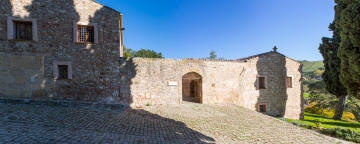Grotte della Gurfa
Grotte della Gurfa
Despite the present name Caves of Gurfa, they are not natural caves modified for men needs, but a rare example of funerary rocky architecture digged through sandstone hills during prehistoric age.
The caves realization can be attributed to that culture which left indelible testimonies in the Mediterranean, recognizable also by the so-called "chamber tombs" and "bell tombs" (tholoi). The first floor of the Grotte della Gurfa architectural complex belongs to the second typology of tombs.
The complex consists in two floors: on the first floor can be found the "tent room" so called due to its gabled ceiling, and the so-called "bell cave", the majestic Thòlos that can be compared, thanks to its size and shape, to the famous Atreus from Micen Treasure. The upper level can be reached from the outside through a narrow staircase carved into the rock which leads into a vestibule from where the other building rooms can be accessed. The historical reconstruction of this monument is quite difficult due to the lack of archaeological finds, in addition to the continuous use of the hypogeum which has partially changed and perhaps eliminated the original structure elements.
However, recent studies on Gurfa tholòs, made by the architect and art historian Carmelo Montegna, have proposed a bold but not improper argument that recognize this place, as a temple dedicated to the cult of the Great Mother (Aphrodite), where the remains of Minos, the legendary king of Crete were laid. According to tradition, in fact, King Minos was buried "in an internal and confidential funerary monumental environment in Kamikos, ... along the Halycos river valley (the modern Platani)..." The caves have been used as set for some scenes of Tornatore´s movie "L´uomo delle Stelle", 1995.









